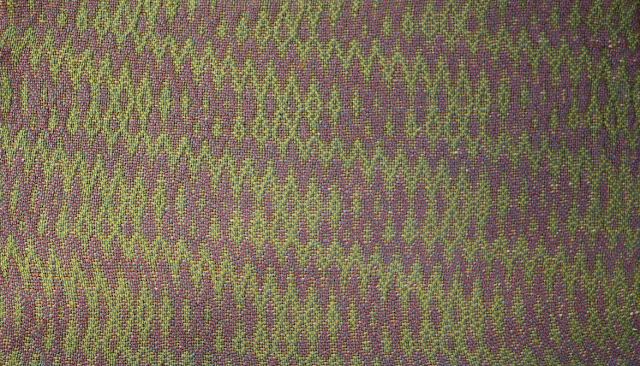You don't need 32 shafts to weave beautiful fabric! I'm on a mission to prove this as I work on designs for a new workshop, "Echo on the Double: 4-Color Double Weave for 4 to 32 shafts." The workshop will include 5 to 6 variations in tieups and treadlings for each pattern, all in double weave, for any kind of treadle loom from 4 to 32 shafts.
Pictured above, in the first 2 photos: Blooming Leaf design, Echo threading on 4 shafts in 4-color double weave, front and back. Second 2 photos: Falling Stars design, Echo threading on 8 shafts in 4-color double weave, front and back. The warp colors for all 4 designs are lime green and azalea.
Double weave on Echo threadings is endlessly fascinating because of the variety of patterns and color combinations that you can achieve. When you start with 2 colors in the warp (for a 2-end parallel threading) and then add 2 colors in the weft (one for the bottom layer and one for the top layer), you're working with 4 colors in all, which keeps color folks like me happy. And sometimes you'll wind up with the appearance of more than 4 colors, as in these samples below.
I used a sky blue and a beige linen as wefts, with lime green and azalea as warp colors. Look closely and you'll see a bit of the blue weft highlighting the pattern on this 8-shaft design.
The back looks quite different. Here, the sky-blue weft alters the lime-green warp, making it appear more like turquoise. It also alters the azalea warp, making it look more lilac.
The color differences are more pronounced when you see this piece "in the flesh."
This color-shift effect is called optical mixing. (I also define it as "simultaneous contrast" because the colors of warp and weft appear different depending on which colors they lie next to). Echo as double weave allows you to exploit and play with this effect, regardless of the number of shafts on your loom.
Above, Blooming Leaf design on four shafts. The warp colors are the same as the 8-shaft design in the photos preceding this. The weft yarn for this layer is sky blue, which again softens the lime green, making it appear turquoise, and shifts the azalea to more of a lavender hue.
For the bottom layer, I used a burnt-orange weft color, which pretty much overwhelms the lime-green warp, turning it into a pale gold/bronze, while the azalea warp becomes more of a coral/orange. I like the bold color differences between the front and the back of the fabric.
There are so many other possibilities as well. For instance, I will be weaving some samples using overtwisted yarns as wefts, which cause the fabric to wrinkle and pleat in interesting ways. The key here is that the design has to include "pockets," as Marian Stubenitsky refers to them in her book, Echo and Iris. This is where the two double-weave layers are weaving separately, which doesn't always happen with double weave on Echo threadings. Often, you're weaving "integrated double weave," where the two layers are interlaced.
And then I would like very much to try weaving with copper as one of the warps and as one of the wefts, but that will have to wait until another time. First, I need to weave up a complete sample set for this workshop. Note: I've found that, as confident as I can be when I look at a design in Fiberworks, I still need to weave it up to see how it plays out. There are often surprises!
Then again, the surprises can lead to discoveries, don't you agree? And discovery is one of the reasons we love this craft.
Thanks for reading!
Falling Stars pattern on 8 shafts, Echo threading, double-weave tieup and treadling,
with overtwisted yarn as one of the wefts.












